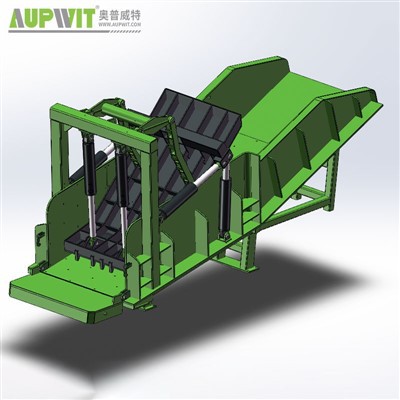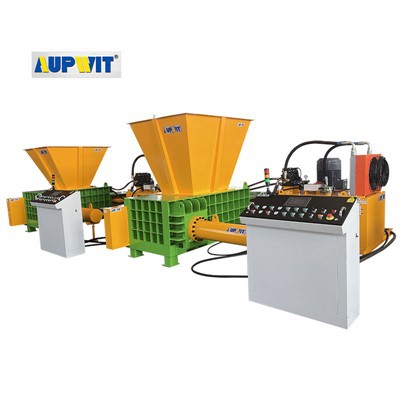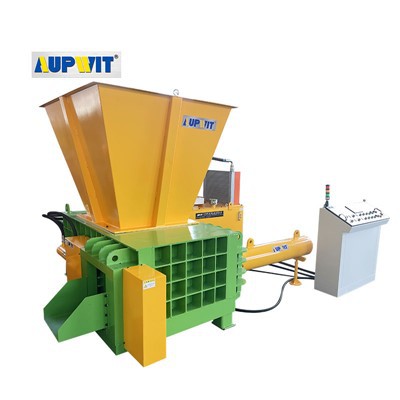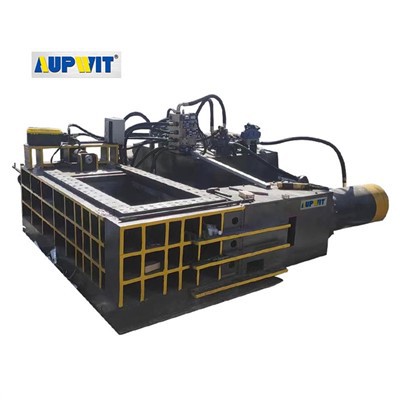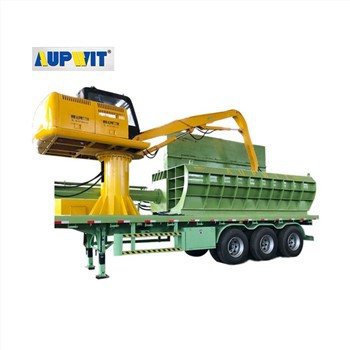Article Outline
1. Introduction to Hydraulic Metal Balers
Hydraulic metal balers represent a critical class of industrial equipment designed for volume reduction and material handling optimization in metal recycling operations. These powerful machines utilize hydraulic pressure systems to compress various forms of metal scrap—including ferrous and non-ferrous materials such as steel, aluminum, copper, and stainless steel—into compact, geometrically regular bales. The fundamental purpose of this compression process is threefold: to minimize transportation costs, facilitate efficient storage, and prepare scrap for metallurgical reprocessing in furnaces :cite[3]:cite[8].
Operational mechanics rely on the principle of plastic deformation induced by extreme compressive forces. When metal scrap is subjected to pressures exceeding its yield strength (typically ranging from 63 to over 5,000 kN), permanent deformation occurs, eliminating internal voids and creating dense, coherent blocks :cite[7]. The process occurs within a constrained chamber known as the "feed box" or "compression chamber," where hydraulic rams systematically compress loose scrap against reaction surfaces. The resulting bales exhibit substantially increased density—typically 1.8 t/m³ or higher for steel scrap—transforming low-density scrap that would be economically unviable to transport into compact parcels optimized for logistics handling :cite[3]:cite[5].
Modern hydraulic balers have evolved beyond basic compression functionality to incorporate sophisticated material handling systems, integrated shearing capabilities, and intelligent control interfaces. These machines now serve as central processing nodes in scrap yards and manufacturing facilities, handling diverse input materials ranging from light-gauge packaging and automotive shredder residue to heavy industrial turnings and demolition steel :cite[1]. The continuous innovation in baler technology reflects the growing economic and environmental imperatives for efficient resource recovery in the circular economy.
2. Technological Evolution
The development trajectory of hydraulic metal balers has been characterized by progressive technological sophistication spanning mechanical design, control systems, and operational methodologies. Early generations employed purely manual valve operation with rudimentary relay-based electrical controls, requiring constant operator intervention and offering limited process repeatability. These systems were prone to reliability issues due to the numerous mechanical contacts and complex wiring inherent in relay logic :cite[7].
2.1 Control System Advancements
The integration of Programmable Logic Controllers (PLCs) marked a revolutionary advancement in baler technology. Modern PLC-controlled balers implement automated sequencing of compression cycles, real-time monitoring of hydraulic parameters, and sophisticated safety interlocks that prevent operation when access doors are compromised :cite[7]. This transition eliminated approximately 85% of the failure points associated with relay-based systems while enabling programmable compression profiles tailored to specific material types. The controller architecture has evolved to incorporate Human-Machine Interfaces (HMIs) that provide operators with visual feedback on cycle status, maintenance requirements, and production statistics. Leading systems now feature remote diagnostics capabilities, allowing technical support personnel to assess machine status and troubleshoot issues without physical site visits :cite[1].
2.2 Hydraulic System Innovations
Hydraulic power units have undergone significant refinement to enhance energy efficiency and responsiveness. Traditional fixed-displacement pump systems have been progressively replaced by variable displacement piston pumps with pressure-compensated controls, reducing energy consumption by 25-40% during partial load operation. Modern systems operate at pressures up to 31.5 MPa (approximately 4,500 psi) while maintaining precise control through proportional or servo-valve technology :cite[3].
Thermal management has emerged as a critical design consideration with the implementation of integrated oil cooling systems and optimized reservoir geometries that promote heat dissipation. For extreme operating environments, specialized balers incorporate oil heating systems to maintain viscosity in cold climates. Hydraulic filtration technology has advanced significantly, with multi-stage filtration systems incorporating pressure and return line filters rated at β₅≥200, substantially extending component life by maintaining oil cleanliness to ISO 16/14/11 standards or better :cite[6].
3. System Components and Engineering
Hydraulic metal balers incorporate several integrated subsystems working in concert to achieve efficient scrap processing. Understanding these components is essential for evaluating baler capabilities and limitations.
3.1 Structural Framework
The structural frame provides the reaction force against which compression occurs. Modern frames utilize high-tensile steel plate (typically ASTM A572 or equivalent) in box-section or reinforced I-beam configurations. Critical stress areas employ wear-resistant materials such as S45C steel plates with hardness ratings of 350-400 HB to withstand abrasion from metal scrap :cite[3]. The frame geometry must balance accessibility for material loading with structural integrity under cyclic loading conditions that can exceed 5,000 kN in industrial balers.
3.2 Hydraulic Actuation System
The hydraulic power unit comprises several key components:
- Prime movers: Typically 7.5-110 kW electric motors or diesel engines for mobile applications :cite[1]:cite[3]
- Pumps
- Actuators: Multi-stage telescopic cylinders for compact installation, with chrome-plated rods and wear-resistant piston seals
- Control valves: Proportional directional valves with position feedback for precise speed control throughout the compression stroke
System architecture typically employs separate circuits for main compression, side compression, lid operation, and ejector functions to optimize performance and energy utilization. Modern systems incorporate hydraulic accumulators to supplement pump flow during peak demand periods, reducing installed power requirements.
3.3 Compression Chamber and Tooling
The compression chamber defines bale geometry and withstands extreme cyclic loading. Standard chamber sizes range from 1000×600×500 mm for smaller units to 4000×1500×700 mm for industrial scrap processors :cite[1]:cite[3]. Chamber construction utilizes replaceable wear liners with specialized surface hardening to extend service life. Compression tooling includes:
| Component | Material Specification | Surface Treatment | Typical Service Life |
|---|---|---|---|
| Main Compression Head | ASTM A514 Steel | Hardfacing (HRC 58-62) | 30,000-50,000 cycles |
| Side Compression Plates | AR400 Abrasion Resistant | Flame hardening | 20,000-35,000 cycles |
| Cutting Blades | H13 Tool Steel | Vacuum hardening (HRC 56-60) | 1,000-2,000 cycles (sharpenable) |
3.4 Ejection and Material Handling
Bale discharge methodologies have evolved to accommodate different operational requirements:
- Forward push-out: Utilizes hydraulic rams to eject bales through the front of the chamber (8-ton force capacity) :cite[3]
- Side-tipping: Rotates the entire compression chamber to deposit bales onto conveyors
- Bottom discharge: Opens the chamber floor for gravity discharge onto transfer systems
The choice of ejection method depends on facility layout, downstream processing requirements, and bale handling equipment. Modern installations increasingly integrate balers with automated material handling systems using programmable logic to synchronize baler operation with conveyor systems and stacking equipment.
4. Performance Metrics and Specifications
Evaluating hydraulic metal balers requires understanding key performance indicators and technical specifications that determine operational efficiency and economic viability.
4.1 Capacity and Productivity Metrics
Balers are classified according to their nominal force capacity, which ranges from compact 63-ton units to industrial 6,300-ton systems :cite[3]:cite[5]. This rating determines the maximum pressure applicable to the scrap material and consequently influences the achievable bale density. Production throughput depends on:
- Cycle time: Typically 60-120 seconds for complete compression cycles (idle cycle time ≈90 seconds) :cite[3]
- Chamber volume: Determines material quantity per cycle (standard sizes: 0.3m³ to 4.2m³)
- Material characteristics: Density, flow properties, and size distribution
Industrial-scale balers achieve production rates of 0.4-0.8 tons/hour for steel scrap, increasing to 1.5-2.5 tons/hour for lower-density non-ferrous materials :cite[3]. The THS-5000 model exemplifies high-capacity processing with 5,000 kN nominal force and 4,000×1500×700 mm feed box dimensions, producing bales measuring 3000×500×400 mm suitable for direct charging into electric arc furnaces :cite[1].
4.2 Bale Density and Quality Parameters
Achievable bale density varies significantly by material type:
| Material Type | Loose Density (kg/m³) | Compressed Density (kg/m³) | Density Increase |
|---|---|---|---|
| Steel Turnings | 900-1,200 | 3,800-4,500 | 320-375% |
| Cast Iron Borings | 1,500-1,800 | 4,000-4,500 | 167-250% |
| Aluminum Chips | 250-350 | 1,400-1,800 | 400-700% |
| Copper Wire | 400-600 | 2,500-3,200 | 525-800% |
| Light Steel Scrap | 300-500 | 1,800-2,200 | 500-600% |
Moisture content significantly impacts bale density for certain materials. Research indicates that baling steel turnings with 49.84% moisture content yields average densities of 244.63 kg/m³, while reducing moisture to 7.77% decreases density by 21.3% due to reduced material cohesion :cite[6]. Premium balers maintain density consistency within ±5% through controlled compression profiles and material conditioning systems.
4.3 Energy and Operational Efficiency
Power requirements scale with force capacity, ranging from 7.5 kW for smaller units to 110 kW for industrial systems like the THS-5000 :cite[1]:cite[3]. Energy consumption per ton varies from 8-15 kWh for light scrap to 25-40 kWh for difficult-to-compress materials. Advanced systems incorporate energy recovery circuits that capture kinetic energy during ram deceleration, reducing net energy consumption by 15-25%.
5. Industrial Applications
Hydraulic metal balers serve diverse industries with specialized requirements for scrap processing and material handling.
5.1 Primary Application Sectors
| Industry | Scrap Sources | Bale Specifications | Special Requirements |
|---|---|---|---|
| Steel Mills & Foundries | Mill scale, rejected castings, slag processing | High density (>3.5 t/m³), standardized dimensions | Compatibility with charging baskets, high throughput |
| Automotive Recycling | Vehicle bodies, engine blocks, shredded residue | 500-1000 kg, compact dimensions | Integrated shearing for tough components |
| Aerospace Manufacturing | Titanium/aluminum chips, trimming waste | High purity, no cross-contamination | Material-specific processing, dedicated systems |
| Electronics Recycling | Copper wire, connectors, shielding | Small bales (15-30 kg), high density | Non-ferrous separation, dust control |
| Municipal Waste Processing | MRF metals, WtE plant residuals | Variable composition, moderate density | High reliability, contamination tolerance |
5.2 Operational Configurations
Balers are implemented in various configurations to match facility requirements:
- Stationary installations: Permanently installed systems with concrete foundations, rated >1,000 tons force for continuous operation
- Semi-mobile systems: Skid-mounted units with quick-connect utilities for periodic relocation
- Mobile balers: Trailer-mounted units powered by onboard diesel engines for remote site operation :cite[6]
Material handling integration significantly impacts overall system efficiency. Modern facilities employ:
- Pre-shredding systems to homogenize feedstock
- Magnetic and eddy current separators for material purification
- Automated conveyor systems with weighing capabilities
- Bale handling equipment including forklift attachments and stacking systems
6. Innovations and Future Trends
The hydraulic baler industry is experiencing transformative technological advancements addressing efficiency, intelligence, and sustainability requirements.
6.1 Smart Baling Systems
Next-generation balers incorporate Industrial Internet of Things (IIoT) capabilities through integrated sensor arrays monitoring:
- Hydraulic pressure profiles during compression cycles
- Oil temperature, viscosity, and contamination levels
- Structural stresses via strain gauge instrumentation
- Motor current signatures for abnormal load detection
These systems implement predictive maintenance algorithms that forecast component failures with 85-90% accuracy, reducing unplanned downtime by up to 50% :cite[1]. Cloud-connected balers enable remote performance benchmarking across fleets, with leading manufacturers developing proprietary analytics platforms that optimize compression parameters based on material characteristics and desired bale specifications.
6.2 Energy Optimization Technologies
Energy efficiency innovations focus on reducing the substantial power requirements of hydraulic compression:
- Variable frequency drives precisely match motor speed to hydraulic flow requirements
- Hydraulic accumulators store energy during low-demand periods for release during compression peaks
- Regeneration circuits capture kinetic energy during ram deceleration and pressure release phases
- Hybrid power systems combine conventional diesel with battery storage for mobile applications
Field trials demonstrate 30-40% energy reduction compared to conventional systems, with payback periods under three years in high-utilization facilities. The industry is exploring fully electric actuation systems using high-torque permanent magnet motors for specialized applications where hydraulic systems present maintenance challenges.
6.3 Material-Specific Processing
Advanced balers incorporate material recognition systems using:
- Spectroscopic analysis for alloy identification
- 3D vision systems for size distribution assessment
- Real-time density measurement during chamber loading
These technologies enable adaptive compression profiles that automatically adjust force application patterns based on material characteristics. For challenging materials like tangled wire or spring steel, manufacturers are developing specialized tooling with interlocking features that prevent material springback. The industry is also exploring hot baling processes where materials are compressed at elevated temperatures below recrystallization points to reduce yield strength and improve density.
7. Conclusion
Hydraulic metal balers have evolved from simple compression devices to sophisticated material processing systems central to modern recycling infrastructure. The continued advancement of these systems reflects growing global imperatives for resource efficiency and circular economy implementation. Contemporary balers achieve unprecedented levels of automation, energy efficiency, and process control through innovations in hydraulic design, structural engineering, and intelligent control systems.
The future trajectory of baler development will focus on enhanced intelligence capabilities through expanded IIoT implementation, further energy optimization to reduce operational costs, and specialized configurations for emerging material streams. The integration of artificial intelligence for predictive maintenance and process optimization represents the next frontier, with potential to increase equipment availability beyond 95% while optimizing bale quality for specific metallurgical processes. As material sustainability becomes increasingly critical to manufacturing economics, hydraulic balers will continue to play a vital role in global resource recovery infrastructure.
8. References
1. Kitairu Machinery. "THS series hydraulic scrap baler-shear". Accessed 2025. :cite[1]
2. Xi Z, He J, Ai W, et al. "Research Progress and Prospects of Hydraulic Metal Balers". Machine Tool & Hydraulics. 2020;48(22). :cite[2]
3. Shanghai Metal Corporation. "Hydraulic Scrap Metal Baler". Accessed 2025. :cite[3]
4. Newton Industrial Dictionary. "Metal Baler". Accessed 2025. :cite[4]
5. Baike.haosou. "Metal Baler". 2016. :cite[5]
6. Development and Evaluation of Off-field Hydraulic Mobile Rice Straw Baler. Misr Journal of Agricultural Engineering. 2015;32(4). :cite[6]
7. 17tex Machinery Design. "Hydraulic Metal Baler Design". 2024. :cite[7]
8. Baidu Baike. "Metal Baler". Accessed 2025. :cite[8]


